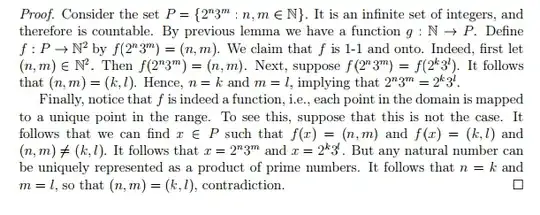There are many ways to construct functions in order to show that $\Bbb N$ and $\Bbb N\times\Bbb N$ have the same cardinality. A bijection can be constructed, but not by using the correspondence $(n,m)\leftrightarrow2^n3^m$. That correspondence doesn't give us a bijection, because not all integers are represented on the right side, indeed, anything with a prime factor greater than $3$ does not occur here.
One can make a bijection according to the strategy outlined at this MSE question: How does one get the formula for this bijection from $\mathbb{N}\times\mathbb{N}$ onto $\mathbb{N}$?, but that's not really necessary. Another way to show that two sets have equal cardinality is to construct injections in both directions.
An injection from $\Bbb N$ to $\Bbb N\times\Bbb N$ is trivial: $n\mapsto (n,0)$ works, for example. In the other direction, sending $(n,m)\mapsto p^mq^n$ for any primes $p$ and $q$ is great.
